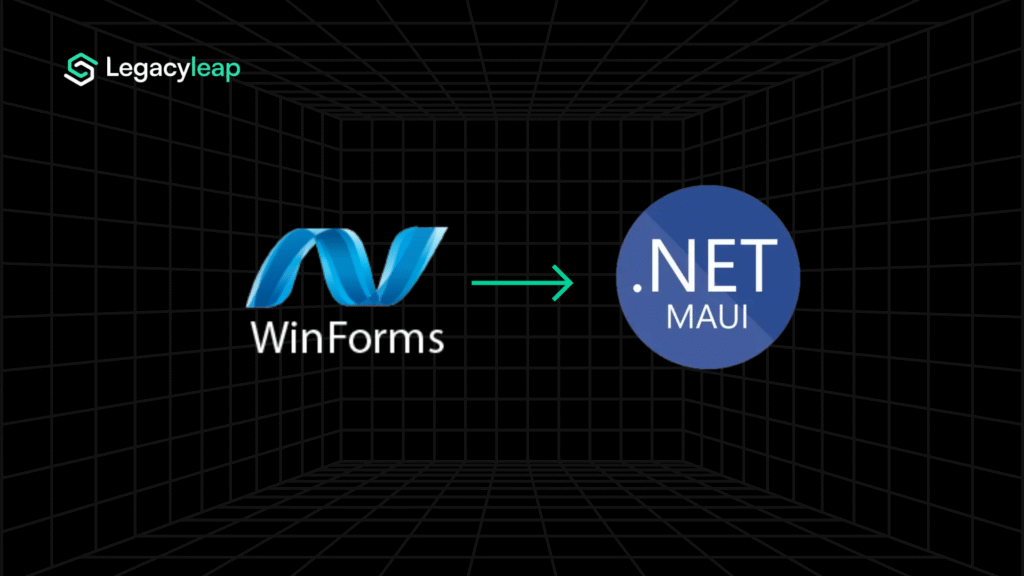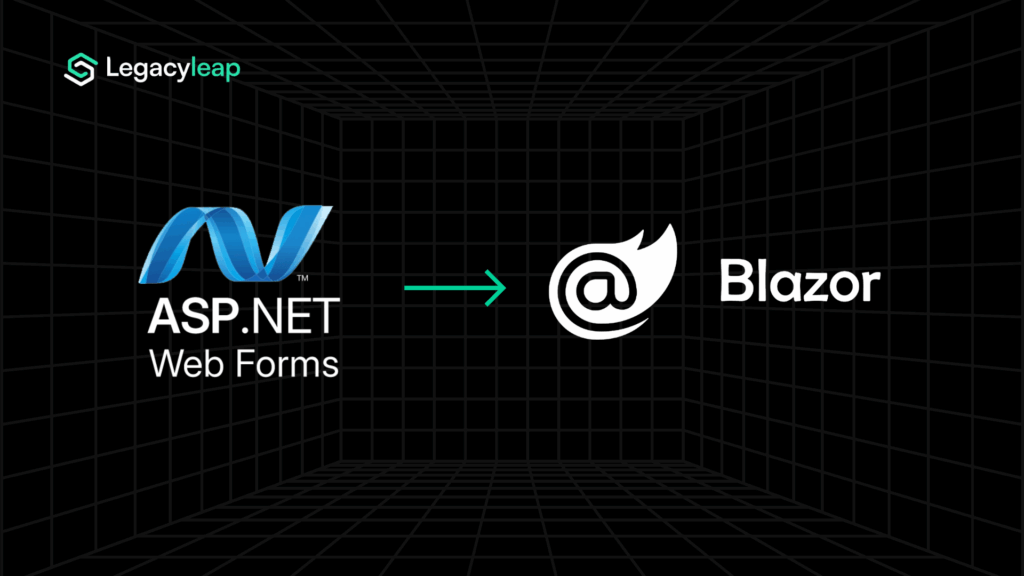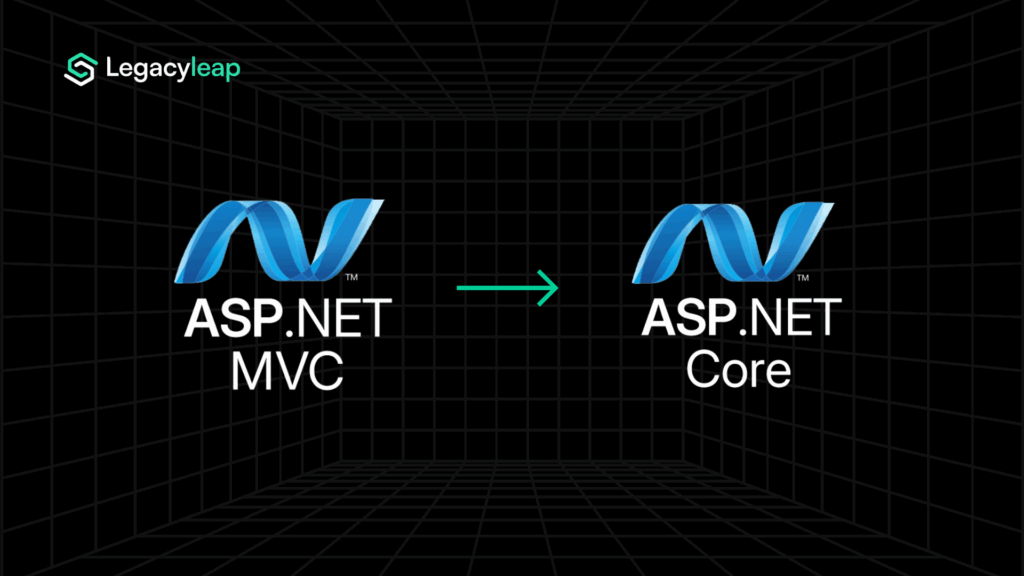Prefer to listen?
This episode of The Legacy2Leverage Show explores the topic in podcast form.
Modernizing legacy systems is no small feat. When a leading transport tech company set out to overhaul their outdated EJB 3 system, they faced mounting challenges: escalating costs, insufficient documentation, and the risk of disrupting mission-critical operations.
General-purpose AI modernization tools like Microsoft Copilot and GitHub Copilot offered some relief but lacked the depth to address the complexities of full-scale modernization.
Using Legacyleap’s Gen AI-powered framework, the company reduced code comprehension time by 50%, streamlined business logic extraction, and ensured smooth modernization—all while maintaining business continuity.
This example highlights a critical difference. Copilots are built for versatility, not specificity. They’re great general-purpose assistants but lack the purpose-built precision needed to tackle the end-to-end challenges of modernization.
Legacyleap, on the other hand, is designed specifically for modernization projects and delivers where it matters—providing purpose-built precision for modernizing complex systems, aligning with business goals, and achieving measurable outcomes.
In the following sections, we’ll unpack the key differences between Copilots and Legacyleap and show how our approach redefines what’s possible in legacy system modernization.
Let’s take a closer look.
Legacyleap vs Copilots – The Case For Purpose-Built Modernization
| Legacyleap | Copilots | ||
| General Code Intelligence | Has all features of a Copilot | – | General Features |
| Data privacy and Security | Installed on Enterprise infra; disconnected from Internet | On Cloud | Security & Privacy |
| Modernization process | Tuned and designed primarily for tried and tested legacy app modernization with well defined steps at every stage of the process. | Solely tuned to write new code. | Core Capabilities & Scope |
| Code Modernization | Code transformation at the repository level | Has code translation capabilities only at code snippet level | |
| Data Modernization | Capabilities available | Not Available | |
| Out-of-the-box recipes for modernization | Pre built | Not Available | |
| Agentic workflows | Provides a team of virtual QA, Dev, Architects and Business Analyists trained for Legacy Modernization as part of the service | Not out of the box | |
| Customization | Flexible | Rigid | Customization & Flexibility |
| IDE | IDE tailored for legacy modernization | General purpose IDE | |
| Code Completion | Context-aware for legacy applications | General code completion that lacks larger business context | |
| Comprehension | Operates at application, module, class, and method levels | Only at code snippet level | Documentation & Comprehension |
| Documentation | Offers comprehensive documentation, including business logic and technical documentation | Provides inline code comments | |
| Diagrams | Provides mind maps, flow charts, and sequence diagrams | Does not provide such visual aids | |
| Sanity and Safety | Ensures safer code conversion with idiomatic constructs, leveraging MLIR and custom-built models | Relies only on LLMs | Code Quality & Safety |
| Bug Fixes | Legacy-context aware bug fixes | Lacks legacy-specific context | |
| Deployment Automation | Available | Not Available | Deployment & Architecture |
| Architecture Revamp | Includes prebuilt templates (e.g., monolith to microservices) | Lacks architecture overhaul capability | |
| Modernization Progress | Monitored via Web UI | Does not offer progress monitoring features | Monitoring & Progress Tracking |
1. General Code Intelligence
Legacyleap: Has all the features of Copilot and more.
Legacyleap provides a comprehensive suite of code intelligence features, covering all the capabilities of tools like Copilot.
While Copilot can assist with code generation and suggestions, Legacyleap goes beyond by offering a complete, purpose-built platform designed specifically for legacy modernization. This ensures a deeper understanding and more accurate solutions tailored to complex modernization tasks.
2. Data Privacy and Security
Legacyleap: Installed on enterprise infrastructure, disconnected from the Internet.
Copilots: On Cloud.
When it comes to modernization, data privacy is paramount. Legacyleap is hosted directly within the enterprise’s secure infrastructure, ensuring that sensitive codebases remain private and are never exposed to external servers, protecting intellectual property (IP) from any potential leaks.
In contrast, Copilot operates in the cloud, which might not offer the same level of control over data security, making it a less suitable choice for enterprises prioritizing privacy.
3. Modernization Process
Legacyleap: Designed for legacy modernization with well-defined steps.
Copilots: Tuned to write new code.
Legacyleap is built as an end-to-end platform specifically for legacy modernization. It covers every stage of the process with well-defined steps – Comprehension, Assessment, Conversion, Safety Nets, Deployment, and Security Governance.
On the other hand, Copilots are not tailored for modernization. While they excel in generating new code, they lack the comprehensive, step-by-step structure required for a seamless modernization journey.
With Copilot, you would need to manually integrate various tools to handle different aspects of modernization, adding complexity and effort to the process.
4. Code Modernization
Legacyleap: Code transformation at the repository level.
Copilots: Limited to code snippet-level translation capabilities.
Code modernization at the repository level ensures that the entire codebase is taken into account, preserving the context and higher-level abstractions necessary for accurate transformation.
Legacyleap’s approach to transforming code at the repository level means that the design and structure of the codebase are properly maintained and improved during the migration process.
By contrast, Copilot’s focus on code snippet-level translation can lead to a loss of context, making the conversion less accurate and potentially introducing issues related to the overall design and correctness of the transformed system.
5. Data Modernization
Legacyleap: Available.
Copilots: Not available.
While GitHub Copilot focuses primarily on code, it does not extend its capabilities to data modernization.
Legacyleap, on the other hand, offers holistic modernization that encompasses not just code, but also data. This means that Legacyleap addresses the entire stack, transforming both application logic and the underlying data structures for a complete modernization solution.
This end-to-end approach ensures that organizations can fully transition to modern technologies across both their code base and data infrastructure, whereas Copilot remains limited to code-level support.
6. Out-of-the-box Recipes for Modernization
Legacyleap: Prebuilt recipes available.
Copilots: Not available.
Legacyleap provides prebuilt recipes for common modernization scenarios, allowing businesses to fast-track their transformation process.
These out-of-the-box recipes eliminate the need to reinvent the wheel for each project, making the overall modernization journey faster and more efficient. By leveraging these recipes, customization time is significantly reduced, enabling quicker deployment and minimizing the effort needed to tailor solutions to specific needs.
Copilots, by contrast, do not provide prebuilt recipes, meaning each modernization task must be created from scratch, slowing down the process.
7. Agentic Workflows
Legacyleap: Offers a virtual team of QA, developers, architects, and business analysts specialized in legacy modernization.
Copilots: Not out-of-the-box.
Legacyleap offers a unique agentic workflow that combines AI agents and human-in-the-loop agents, including QA engineers, developers, architects, and business analysts. This hybrid approach ensures that AI tools are augmented by human expertise, resulting in more accurate, efficient, and context-aware outputs.
The team works in tandem to ensure each aspect of the modernization process is expertly handled. The AI agents handle repetitive tasks, while human-in-the-loop agents oversee complex decisions and ensure high-quality outcomes.
Copilot, however, relies on one-off AI-driven calls without the coordinated, multidisciplinary team approach, meaning it lacks integrated support for the complete modernization journey.
8. Customization
Legacyleap: Flexible.
Copilots: Rigid.
Legacyleap offers turnkey modernization that is highly flexible, allowing for quick adjustments and customizations to fit the specific needs of each customer. This adaptability is key in tailoring the modernization process to meet unique business and technical requirements.
Copilots, by contrast, are rigid tools that provide limited customization options. Even if you wanted to customize them, it would require significant effort and expertise, as they are not built with flexibility in mind for legacy-specific needs.
9. IDE
Legacyleap: Tailored for legacy modernization.
Copilots: General-purpose IDE.
Legacyleap provides an IDE specifically designed for legacy modernization, offering a customized environment that streamlines the transformation process. This dedicated IDE includes specialized interfaces, actions, and capabilities that are directly aligned with the needs of modernizing legacy applications.
Copilots, on the other hand, are typically general-purpose IDE plugins that serve a broad range of development tasks but lack the tailored focus necessary for the complex requirements of legacy modernization.
This means that using Legacyleap’s specialized IDE allows for faster and more accurate modernization, as it is purpose-built for this specific journey.
10. Code Completion
Legacyleap: Context-aware for legacy applications.
Copilots: No information.
Legacyleap’s code completion is context-aware for legacy applications, meaning it understands the specific requirements, patterns, and structures of legacy systems. This ensures that the code suggestions, bug fixes, and improvements are directly relevant to the legacy application being modernized, thus increasing the quality and accuracy of the transformation.
Copilot, by contrast, typically offers general code completion based on code or language syntax, but lacks an understanding of the larger application context, leading to less relevant suggestions and a greater chance for errors or misalignments in the modernized code.
11. Comprehension
Legacyleap: Operates at application, module, class, and method levels.
Copilots: Works at a code snippet level.
Comprehending legacy systems goes beyond analyzing isolated code snippets—it requires a holistic understanding of the entire application structure.
Legacyleap offers deep insight at multiple levels, including application, module, class, and method levels, enabling developers to grasp the full context of the system. This level of comprehension leads to better decision-making and more efficient modernization.
Copilots, however, operate at a much more limited scope, focusing on code snippets. This makes it harder to understand the broader context of a legacy system and slows down the process of making informed, high-level decisions for modernization.
12. Documentation
Legacyleap: Offers comprehensive documentation, including business logic and technical documentation.
Copilots: Provides inline code comments.
Effective documentation is essential for successful modernization. Legacyleap generates comprehensive documentation, not just for code but also for the underlying business logic, providing valuable context for the transformation process.
This holistic approach allows developers to understand both the technical and business requirements behind the legacy system, speeding up the modernization process.
Copilots, on the other hand, only provide inline comments, which are limited to technical aspects and often miss out on business context. This can leave gaps in understanding, making the transformation more challenging and error-prone.
13. Diagrams
Legacyleap: Provides mind maps, flow charts, and sequence diagrams.
Copilots: No information.
Legacyleap enhances the modernization process by offering comprehensive diagrams like mind maps, flow charts, and sequence diagrams, which help to visualize the system’s structure and logic.
These diagrams provide clear, visual documentation, making it easier for developers to understand the codebase and speed up the transformation process. With these visual aids, developers can grasp the legacy application’s design and logic faster.
Copilot, on the other hand, does not provide such visual aids, meaning developers may need to invest more time in understanding the code manually.
14. Sanity and Safety
Legacyleap: Ensures safer code conversion with idiomatic constructs, leveraging MLIR and custom-built models.
Copilots: Relies only on LLMs.
Sanity in the context of legacy modernization means more than just code generation—it’s about producing correct and idiomatic code that minimizes manual intervention and reduces errors.
Legacyleap achieves this by using MLIR (Multi-Level Intermediate Representation) and custom-built models, ensuring that code conversion remains accurate and reliable. This approach ensures that the target code is both syntactically correct and idiomatically sound for the target language, providing a safer and more efficient modernization process.
On the other hand, Copilots, which rely solely on Large Language Models (LLMs), do not provide the same level of assurance in terms of safety, often leaving developers to handle issues manually.
15. Bug Fixes
Legacyleap: Legacy-context aware bug fixes.
Copilots: No information.
When it comes to bug fixes, Legacyleap takes into account the specific nuances and requirements of legacy applications, ensuring that the fixes are context-aware. This results in more accurate and effective bug resolutions, reducing the risk of introducing new issues during modernization.
Copilot, in comparison, lacks this legacy-specific context, which means that its bug fixes may not align well with the intricacies of older systems, potentially leading to further complications during the modernization process.
16. Deployment Automation
Legacyleap: Available.
Copilots: Not available.
Deployment automation significantly speeds up the modernization process by generating deployment artifacts alongside code transformation.
Legacyleap automatically generates all necessary deployment artifacts, such as Helm charts for Kubernetes or Terraform scripts for EC2, to ensure seamless, automated deployment. This eliminates manual intervention, reducing deployment time and errors.
In contrast, Copilot lacks this capability, requiring additional manual work for deployment and slowing down the overall process.
17. Architecture Revamp
Legacyleap: Includes prebuilt templates (e.g., monolith to microservices).
Copilots: Not available.
Modernization isn’t just about code migration—sometimes, a full architecture revamp is necessary to take full advantage of modern technologies and cloud-native designs.
Legacyleap offers prebuilt templates and frameworks, such as monolith-to-microservices, that allow organizations to transform their application architecture in line with modern best practices. This ensures that the entire system is optimized for scalability, flexibility, and cloud-readiness.
Copilot, however, lacks this architecture overhaul capability, focusing only on code-level transformation, and therefore doesn’t provide the support needed for a complete technical revamp.
18. Modernization Progress
Legacyleap: Monitored via Web UI.
Copilots: Not available.
Legacyleap offers comprehensive monitoring of the modernization process via a web UI, giving a clear view of the entire journey. This feature is invaluable for tracking progress, ensuring alignment with goals, and enabling non-technical stakeholders to participate in governance and decision-making.
With this transparency, teams can identify which applications to prioritize, manage progress, and stay motivated with clear visibility.
Copilots do not offer a similar progress monitoring feature, meaning the team would have to track progress manually, which could result in inefficiencies and a lack of alignment across stakeholders.
Final thoughts
While Copilots provide valuable support for code generation, Legacyleap is a comprehensive, end-to-end solution tailored specifically for legacy modernization.
With advanced AI-driven capabilities combined with a platform designed to handle the full lifecycle of modernization – encompassing code conversion, documentation, deployment, and architectural revamps – Legacyleap provides an unmatched, context-aware approach.
Unlike Copilots, which focus on isolated tasks, Legacyleap ensures a holistic, secure, and customizable solution that integrates AI agents and human expertise for superior results. With pre-built recipes, detailed progress tracking, and built-in safety nets, Legacyleap guarantees not only faster modernization but also greater accuracy and alignment with business goals.
For organizations seeking a reliable, scalable platform for legacy modernization, Legacyleap offers the most efficient, secure, and adaptable choice. Reach out to us today to explore Legacyleap further!








